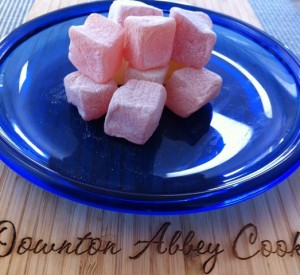
I love entertaining and grew up with horses so I was thrilled with the Fox hunt episode. But alas horse lovers, it is not the fox hunt which makes the episode memorable; rather it is the tragic consequences of a dangerous liasion. While the death of two heirs was tragic, the outcome of this episode results in secret pacts which sends ripple effects far and wide thoughout the land, as well as future story lines.

This famous episode (S1E3) in which Lady Mary meets Kemal Pamuk, the handsome diplomat, was very well conceived and written in my mind. It is hard to imagine such sparks flying from a casual walk around the gardens or Afternoon Tea. So the thrill of a fox hunt, an activity which aristocracy often participated in–and which women were often a part of–provides the perfect ignition for the dangerous liaison. As a morality play, I believe that the message here is a strong one. To be “pamuked”, a phrase now in circulation amongst Downton fans, should not refer to the act, but to a general statement about bad choices. A Mary musing which we should all take to heart: “Aren’t all of us stuck with the choices we make?”
Fact vs Fiction
Julian Fellowes has had to defend Downton Abbey from many historians who take issue with historical accuracy. Even the Horse & Hound set had their say about how the hunt was portrayed. Writers do their best but in the end this is a drama and not a documentary. However, for the sticklers in the crowd:
- Fiction: Kemal Pamuk is referred to as a Turk from Istanbul. When Thomas asks about Turkey, Mr. Pamuk answers that it is a nice country. However, the Republic of Turkey was not established until 1923, and Istanbul was not officially renamed until after the start of WWI.
- Fiction: There were no surnames in Ottoman Empire or in Turkish Republic until 1934. So, there would not have been a Kemal Pamuk in that time period.
- Fact: the Pamuk incident was based on a true story
- Fact & Fiction: history of the fox hunt and quibbles from Horse & Hound members about how accurately the hunt was portrayed.
Good news, Mr. Pamuk Fans: Theo James comes to America
As reported today at Vulture.com, Downton Abbey’s Theo James–who played Mr. Pamuk–will be replacing Ryan Phillippe in Greg Berlanti’s CBS cop drama Golden Boy. He will be portraying a police officer on a fast-track career path. The Downton Effect: great outcome for an actor who made a lasting impression in only one episode on the show.
What a Turkish Delight
I would not be true to my sarky leanings if I didn’t play up on the eye candy analogy. Personally I don’t see the attraction of Pamuk (I have a very tall, dark and handsome husband to gaze upon every day), but Mary, the housemaids and Thomas were certainly struck by a foreigner…maybe it was the long hair.
I have said many times that British of the day loved their jellied desserts, so you should not be surprised that artistocracy loved Turkish Delights, a chewy confectionary you can still buy today. I remember that my father loved the turkish delight candy bars, covered in chocolate. Lokum, an Istanbul creation, was introduced to Western Europe in the 19th century. An unknown Briton reputedly became very fond of the delicacy during his travels to Istanbul and purchased cases of it, to be shipped back to Britain under the name Turkish Delight. It became a major delicacy in Britain and throughout Continental Europe for the high class society. During this time, it became a practice among upper class socialites to exchange pieces of Turkish Delight wrapped in silk handkerchiefs as presents.
Turkish Delight: Easy Version

Making your own Turkish Delight is simple in terms of ingredients, but is a bit time consuming in execution. It is definitely a make ahead dish to get the best result. You don’t want to rush a good thing. While this version is not traditional, it does use gelatin which the Edwardians loved so you could call it their method of making this treat.
Ingredients
- 3 envelopes unflavoured gelatin
- 2 cups sugar (or sugar substitute)
- 1 cup water
- 2 tsp. – 1 tbsp. rosewater
- 1 tbsp. fresh lemon juice
- 1 tsp. lemon zest
- red food coloring
- 1 cup icing sugar
- 3 tbsp. cornstarch
Method
- Mix gelatin, sugar in a medium saucepan.
- Add water and stir to combine.
- Bring to a slow boil, stirring to prevent burning, then simmer without stirring for 10 minutes.
- Remove from heat and add the rosewater, lemon juice and zest.
- Pour into an 8 inch square plastic container which has been rinsed, but not dried.
- Let set overnight.
- Remove from the container and cut into squares.
- Combine the cornstarch and icing sugar and put in your plastic container.
- Put the cubes into the mixture and ensure they are coated to form a crust.
Turkish Delight: Traditional Method (Advanced)
Ingredients:
For the candy
- 4 cups granulated sugar
- 1 tbsp. real lemon juice
- 1 1/2 cups water, plus an additional 2 3/4 cups
- 1 cup cornstarch
- 1 tsp. cream of tartar
- 1 tbsp. vegetable oil
- 1 tsp. rose water
- 1 tsp. orange extract
- yellow food coloring
- red food coloring
For the coating:
- 2 lb. bag icing sugar
- 1 cup cornstarch
Method
Day One
- In a medium, heavy-bottomed saucepan combine sugar, lemon juice, and 1 1/2 cups water. Bring to a boil over medium heat, stirring until the sugar dissolves. Reduce heat and simmer until the mixture reaches 240F, or soft ball, on a candy thermometer. Alternatvely/double check, drop a little bit into cold water. It should have the texture of a chewy ball. A few degrees higher is better.
- In a large, heavy-bottomed saucepan combine 3/4 cups water with cornstarch and cream of tartar. Stir, removing all lumps. Add remaining 2 cups of water. Stirring continuously, heat the mixture over low until it bubbles, turning thick and glossy. A wooden spoon will stick straight up in the glue-like mixture.
- Ladle a little of the sugar mixture at a time into the cornstarch mixture. Completely whisk each ladle of the sugar mixture into the cornstarch mixture, until it is fully incorporated. Your bicep will be burning when you are done, and the mixture will form thick ribbons when dangled from the whisk. Don’t rush or you will get lumps. If you get lumps it will not thicken up properly.
- Once the mixture is smooth and combined, heat on low for another hour, stirring occasionally. There should be no bumps.
- Meanwhile oil two 8″ metal square pans.
- Work quickly once the mixture is off the heat. Separate mixture into 2 small bowls. To the first bowl: add rose water and one drop of red food coloring, making a pink hue. To the second bowl: add orange extract and at least 4 drops of yellow food coloring, making an orange hue. 6. Working quickly, pour one mixture into each casserole, making sure it flows evenly. Note if you go too slowly, the mixture will set up in mounds and there isn’t too much you can do about it.
- Clean up your dishes right away.
- Let sit, covered, for 24 hours. Do not refrigerate.
Day Two
- Unmold the candy onto a clean, odor free cutting board (or counter). Using an oiled knife, slice the Turkish Delight into bite size pieces: 1? x 1.5?.
- In a large bowl, sift together cornstarch and confectioner’s sugar.
- Fill a large casserole with the 1/2 coating mixture (confectioners sugar and cornstarch). Lay out the Turkish Delight carefully, leaving at least 1/4? between each candy.
- Cover with remaining 1/2 of the coating mixture.
- Now that the Turkish Delight is buried in the coating, let stand, covered, for 2 days. This critical step develops a crust that keeps the soft, moist interior from sweating outwards. If some candies do start to “emerge” from their sugary bed, just cover them back up.
TURKISH DELIGHT
Ingredients
Turkish Delight: Easy Version-
- 3 envelopes unflavoured gelatin
- 2 cups sugar (or sugar substitute)
- 1 cup water
- 2– 1 tbsp. rosewater
- 1 tbsp. fresh lemon juice
- 1 tsp. lemon zest
- red food coloring,
- 1 cup icing sugar
- 3 tbsp. cornstarch
Turkish Delight: Traditional Method (Advanced)-For the candy
- 4 cups Granulated sugar
- 1 tbsp. real lemon juice
- 1 1/2 cups water plus an additional 2 3/4 cups
- 1 cup cornstarch
- 1 tsp. cream of tartar
- 1 tbsp. vegetable oil
- 1 tsp. rose water
- 1 tsp. orange extract
- yellow food coloring
- red food coloring,
Turkish Delight: Traditional Method (Advanced)-For the candy-For the coating:
- 2 lb. bag icing sugar
- 1 cup cornstarch
Instructions
Turkish Delight: Easy Version-
- Mix gelatin, sugar in a medium saucepan.
- Add water and stir to combine.
- Bring to a slow boil, stirring to prevent burning, then simmer without stirring for 10minutes.
- Remove from heat and add the rosewater, lemon juice and zest.
- Pour into an 8 inch square plastic container which has been rinsed, but not dried.
- Let set overnight.
- Remove from the container and cut into squares.
- Combine the cornstarch and icing sugar and put in your plastic container.
- Put the cubes into the mixture and ensure they are coated to form a crust.
Turkish Delight: Traditional Method (Advanced)-Method Day One
- In a medium, heavy-bottomed saucepan combine sugar, lemon juice, and 1 1/2 cups water. Bring to a boil over medium heat, stirring until the sugar dissolves. Reduce heat and simmer until the mixture reaches 240F, or soft ball, on a candy thermometer. Alternatvely/double check, drop a little bit into cold water. It should have the texture of a chewy ball. A few degrees higher is better.
- In a large, heavy-bottomed saucepan combine 3/4 cups water with cornstarch and cream of tartar. Stir, removing all lumps. Add remaining 2 cups of water. Stirring continuously, heat the mixture over low until it bubbles, turning thick and glossy. A wooden spoon will stick straight up in the glue-like mixture.
- Ladle a little of the sugar mixture at a time into the cornstarch mixture. Completely whisk each ladle of the sugar mixture into the cornstarch mixture, until it is fully incorporated. Your bicep will be burning when you are done, and the mixture will form thick ribbons when dangled from the whisk. Don’t rush or you will get lumps. If you get lumps it will not thicken up properly.
- Once the mixture is smooth and combined, heat on low for another hour, stirring occasionally. There should be no bumps.
- Meanwhile oil two 8″ metal square pans.
- Work quickly once the mixture is off the heat. Separate mixture into 2 small bowls. To the first bowl: add rose water and one drop of red food coloring, making a pink hue. To the second bowl: add orange extract and at least 4 drops of yellow food coloring, making an orange hue. 6. Working quickly, pour one mixture into each casserole, making sure it flows evenly. Note if you go too slowly, the mixture will set up in mounds and there isn’t too much you can do about it.
- Clean up your dishes right away.
- Let sit, covered, for 24 hours. Do not refrigerate.
Turkish Delight: Traditional Method (Advanced)-Method Day Two
- Unmold the candy onto a clean, odor free cutting board (or counter). Using an oiled knife, slice the Turkish Delight into bite size pieces: 1? x 1.5?.
- In a large bowl, sift together cornstarch and confectioner’s sugar.
- Fill a large casserole with the 1/2 coating mixture (confectioners sugar and cornstarch). Lay out the Turkish Delight carefully, leaving at least 1/4? between each candy.
- Cover with remaining 1/2 of the coating mixture.
- Now that the Turkish Delight is buried in the coating, let stand, covered, for 2 days. This critical step develops a crust that keeps the soft, moist interior from sweating outwards. If some candies do start to “emerge” from their sugary bed, just cover them back up.
This will make 50 pieces. Enjoy your Turkish Delight! Store leftovers in the coating mixture. Do not refrigerate.


